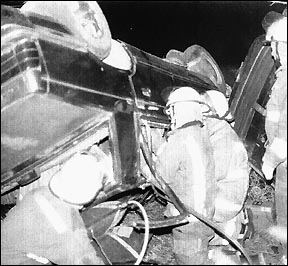Drill tests new rescue rig
 A three-car accident was used in a mock drill to put the Paynesville Fire Department's new rescue vehicle to the test on Monday, Nov. 19.
A three-car accident was used in a mock drill to put the Paynesville Fire Department's new rescue vehicle to the test on Monday, Nov. 19.Paynesville fire fighters and ambulance members worked toe xtradicate an injured person from an overturned vehicle during the drill.
The fire department holds a large-scale drill once a year, according to Jeff Ruprecht, training officer. The two-hour drill was held on Roseville Road west of town. It demanded that fire fighters work with emergency medical technicians from the Paynesville Ambulance Corps, who took part in the joint drill.
Drilling together is especially important because the fire department and ambulance squad work together frequently. Fire fighters help with more medical emergencies than fires, said Paynesville Fire Chief Jim Freilinger. In recent years, two-thirds of the fire departments calls have been medicals and only one-third actually fires.
The mock accident was designed to be an especially difficult test - for both the rescue personnel and the fire department's new fire and rescue vehicle. The new vehicle has been in service for six months, but the drill tested all its features.
The vehicle is equipped with lights, unlike its predecessor, and is designed to serve as a command post in an emergency. It has an electrical generator that is hooked directly to the engine and can be activated with a flip of the switch. The generator provides emergency lighting and electricity.
The vehicles were placed to provide great challenges during the rescue, said Freilinger. One vehicle was upside down with a victim trapped inside while another vehicle was on its side leaning against the overturned vehicle. A third vehicle was down in a ditch, out of sight from passing motorists. Its driver had been thrown from the vehicle and fire fighters had to locate him in the dark.
The mock accident required extrication, working at night, splitting into two groups as a second vehicle was 75 yards away, searching and rescuing a victim who had been thrown from the car, and securing the site before the ambulance personnel could administer medical care. "We threw in as many variables as we could," Freilinger said.
"The vehicles presented a challenge with battery acid leaking, gasoline and oil dripping from the vehicle. The roof was also partially crushed," said Ruprecht. The fire fighters found the integrity of the vehicle was about to collapse, endangering the fire fighters as well as the victim.
In most accidents, firefighters can remove a victim from a vehicle in less than 20 minutes. Because of the condition of the vehicle and with the accident victim not having life threatening injuries, it took 45 minutes to remove the victim from the overturned vehicle, Ruprecht said.
If weather conditions or the victim's injuries had been more severe, the victim could have been removed faster, Ruprecht added.
The mock victims were treated for injuries and transported to the Paynesville Area Hospital.
According to Ruprecht, the rescue vehicle and the rescue personnel passed the training test with flying colors. "We wanted to be sure the vehicle had adequate lighting for a night rescue," he said.
The new vehicle can transport 13 fire fighters, in addition to the department's equipment for medical, fire, and accident calls. It cost $137,000.
Contact the author at paypress@lkdllink.net • Return to News Menu
Home | Marketplace | Community